This blog, in the backdrop of World Soil Day, 2021, is a gentle reminder of the importance of practicing sustainable land management. Well-framed policies and extension functionaries capable of educating farmers on sustainable soil management are absolutely necessary to protect soils, opine Trisha Roy, Gopal Kumar and M Madhu in this blog.
CONTEXT
Soil is at the core of various ecosystem services provided by our planet Earth; and 95 percent of the food consumed by the global population comes from soils. Thus, taking care of this non-renewable natural resource is one of the most important duties of every citizen. However, we have neglected our soils for too long and we are paying the price now. Land degradation – in the form of erosion, chemical degradation, physical degradation and desertification – is looming large across all continents and we are losing this priceless resource inch by inch. The celebration of World Soil Day is a part of the global campaign to save our soil resources, which was initiated in 2014, and since then, every year on 5 December we celebrate ‘World Soil Day’, to raise awareness on how important this resource is for the survival of all living organisms.
LAND DEGRADATION DURING THE COVID-19 PERIOD
We are at the crossroads where the strain on our natural resources is very high due to increasing population pressure, and simultaneously the quality of our natural resources are deteriorating due to over-exploitation. Land degradation is one of the foremost challenges which impact all live forms on this planet. The alarming rate of land degradation has spread across one-third of the earth’s land resources and it is expected that 90 percent of the land will be in peril by 2050 if an action-oriented approach to protect land resources is not adopted globally (Brown 2020 https://www.triplepundit.com/story/2020/world-soil-day/708946). Over the past 50 years, industrial development, progress in the technological field, and altered consumption patterns have dramatically impacted all ecosystems, putting over one million species at risk. Our soils are lost at a rate of 10 to 40 times higher than its formation rate, indicating how rapidly we are progressing towards a point of no return.
All these issues have become more pronounced with the arrival of the COVID-19 pandemic. This has put immense stress on the already vulnerable systems worldwide and poses a real challenge to the achievement of Land Degradation Neutrality (LDN) by 2030. This pandemic is expected to increase the number of starving people from 135 million to more than 250 million around the globe (https://www.wfp.org/). Also, it has hit the agricultural labour force very hard forcing them to reverse migrate from urban to rural areas. These can have a far flung influence and is likely to affect our already impoverished land resources negatively. The land is at the receiving end of this vicious cycle, thus getting poorer by the day.
The emergence of diseases, like COVID-19, has also highlighted the importance of sustainable land management. Anthropogenic infringement into the natural ecosystem and disrupting the balance has been stated as one of the root causes of increased novel infectious diseases occurring in humans and livestock that are transferred from wildlife (UNCCD 2020). Land use changes often drive wild animals from their habitat, leading to increased human-wildlife conflicts. This heightens the risk of disease transmission and microbial alterations from wildlife to domestic animals and human systems, which is referred to as zoonosis. Land use changes have been identified as the primary transmission pathway for various emerging infectious diseases in humans, 60 percent of which is zoonotic in nature. The main aim of delving into diseases – taking a side track from sustainable land management and land degradation – is only to highlight how important it is to act and protect these natural resources, which if left unattended would soon bring doomsday upon us.
SOIL EROSION: A MAJOR CAUSE OF LAND DEGRADATION
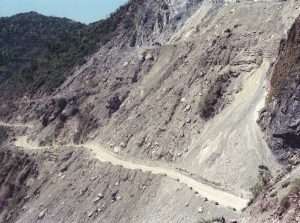 Landslides in the unstable slopes on North Western Himalayas
Landslides in the unstable slopes on North Western Himalayas
Of the various forms of land degradation affecting the soil, water erosion is one of the main forms that move healthy, fertile soil from one place to another transforming productive landscapes into barren lands. India has been reeling under the problems of water erosion which happens to impact about 83 m ha area of the country (Mandal and Sharda 2011). Though soil erosion is as ancient as the advent of human civilization or may be even older, it is the accelerated rate of soil loss which poses a serious threat to the ecosystem today. Erosion reduces the productive capacity of land resources, diminishes the soil of its various essential functions, deteriorates soil properties and also aggravates the phenomenon of climate change. The deposition of translocated soil to oceans, water bodies, etc., reduces the storage capacity of reservoirs, increases natural disasters such as flooding. Furthermore, erosion results in the loss of huge amounts of biodiversity, which often goes unaccounted.
In India, the impact of water erosion in terms of production losses is estimated to be 13.4 million tonnes with a monetary valuation of $ 2.51 billion (Sharda et al. 2010). If soil loss is quantified in terms of nutrient and C losses, erosion of 1mm top soil from 1 ha land results in loss of 150-225 kg C, 12.97-28.26 kg N, 1.14-6.79 kg P, 13.03-25.5 kg K and 3.74-4.85 kg S (Mandal 2014). In terms of energy, to compensate the nutrient loss of N, P, K and S through inorganic fertilizers, 1592 MJ of energy expenditure per ha is required. Thus, compensation of erosion losses is a costly affair, and what’s more, it has a detrimental impact on the overall ecosystem with intangible losses in terms of ecosystem services, soil health and food security.
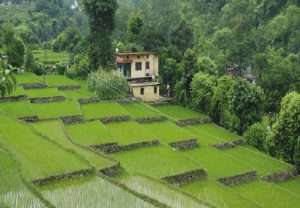 Bench terraces: an effective measure of soil conservation for arable lands
Bench terraces: an effective measure of soil conservation for arable lands
TACKLING SOIL EROSION: PAST, PRESENT AND FUTURE
Technologies and management options to avert and arrest soil erosion has been in place for a very long time. However, their real time application on a priority basis is often lacking. Time-tested soil conservation measures such as land levelling, contour bunding, field bunding, terracing, strip cropping, reduced and minimum tillage, cover crops, mulching, inter-cropping, residue retention, conservation agriculture, trenching, etc., have been age-old methods for soil and water conservation. All these conservation measures – in combination or alone – are applicable in different agro-ecological regions of the country. All these conservation measures have the capacity to combat soil erosion and improve water conservation. However, if we see the execution pattern of these technologies at the farm scale, the right approach is missing. Though the farmers have know-how of various techniques they are often reluctant to execute because of the cost or inconvenience of adopting the conservation measures. Integrated Watershed Management Programs (IWMP), which was once a flagship programme of the Government of India, had much success in terms of soil and water conservation. The IWMPs were executed in the backdrop of sustainable land management or rather sustainable natural resource management with due emphasis on livelihood security and economic enhancement of the people living in the watershed. With time the IWMP has gone out of focus, and presently the IWMP has been merged with various other schemes under the Pradhan Mantri Krishi Sinchayi Yojna.
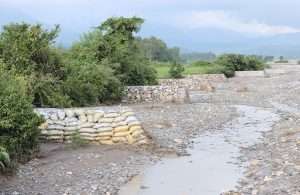 Spurs for controlling flow of torrents
Spurs for controlling flow of torrents
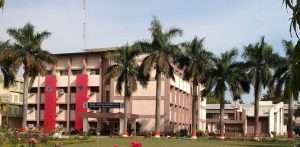 ICAR-Indian Institute of Soil and Water Conservation, Dehradun, Uttarakhand
ICAR-Indian Institute of Soil and Water Conservation, Dehradun, Uttarakhand
The success story of watershed development at ICAR-IISWC (Indian Institute of Soil and Water Conservation) was etched with the Sukhomajri Project in the Panchkula district of Haryana, which was a model watershed in the country. Following suit various other watershed projects were taken up by ICAR-IISWC, Dehradun, and its regional Centres such as the Fakot, Langha, Rabari, Jigna, Salaiyur, Raghupur, Mandhala, etc. (Bagdi et al. 2015). However, as the focus has shifted away from watershed management programmes it is time to initiate newer strategies to tackle the problems of soil erosion at the farm level.
The approach of Sustainable Land Management (SLM) involves ‘the use of land resources including soil, water, animal and plants, for production of goods to meet changing human needs while ensuring long term productive potential of these resources and the maintenance of their environmental functions’. SLM will help in selecting the most appropriate land use for a given bio-physical and socio-economic condition so as to avoid further land degradation, rehabilitate degraded land, and ensure maximizing the resilience of land resources. SLM is based on five principles:
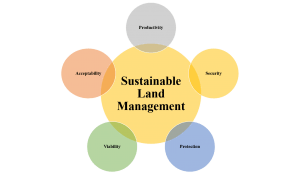 Five pillars of Sustainable Land Management
Five pillars of Sustainable Land Management
Achieving SLM and reducing soil erosion is a major task which needs a big shift in the way agriculture and allied sectors are functioning in the country. The implementation of SLM would involve more data intensive and technologically advanced practices such as precision agriculture, use of sensors, drones, precision water management systems, which will not only optimize the use of various agriculture inputs but also enhance system productivity by minimizing losses. This would also help to build a stable ecosystem and lower the C output. The most crucial part of SLM is the selection of appropriate land use which is acceptable across the social strata while fulfilling all the other four criteria of SLM. For example, in the north-west Himalayan region, farmers practice the maize-wheat cropping system intensively. Loss of 1 ton soil in the Lower Himalayan Region results in loss of maize yield to the tune of 15 kg/ha grain (Mandal et al. 2015), with a cumulative energy loss of 655.5 MJ (Sharda et al. 2019). In order to make this land use system sustainable any conservation measure such as mulching, intercropping, crop residue retention, improving soil aggregation using microbes, etc., which prevents soil loss is necessary.
Simple practices – integrated nutrient management, use of well-decomposed manure, soil testing to identify deficiencies, choosing proper crop rotation and cropping cycle, green manuring practices, inclusion of bio-fertilizers in the fertilizer schedule, micro-irrigation techniques, on-farm water harvesting, timely forecasting of weather as well as pest and diseases control – can together help in achieving sustainability at the farm level. Well-framed policies and technologically-equipped field functionaries are necessary to disseminate these improved practices and validate the already existing ones at the lowest level of farmers/stakeholders.
END NOTE
This article in the background of World Soil Day, 2021, is a gentle reminder on how important this natural resource is for the sustenance of life on Earth. Though time and again we are reminded and sensitized to act, somehow there remains a missing link. It’s time we rise up to the cause and understand that our future generations are in jeopardy because of our misdeeds today as we tend to ignore the soil every time we step on it. The health of the soil is reflected on how healthy our life is. Sadly we are all turning sick. Until and unless we nurture our soil we will continue remaining sick until we perish in the soil itself. Reese (2014) has rightly highlighted that ‘Soil erosion may get us before climate change does’ as history has witnessed the downfall of several prosperous civilizations due to mismanagement of its soils (Scholes and Scholes 2013). Let us unite together for this vital cause for sustainable soil management with the pledge to present a better planet to our future generations.
REFERENCES
Bagdi GL, Mishra PK, Kurothe RS, Arya SL, Patil SL, Singh AK and Sundarambal P. 2015. Post-adoption behaviour of farmers towards soil and water conservation technologies of watershed management in India. International Soil and Water Conservation Research 3(3):161-169.
Mandal D. 2014. Save soil to save civilization. In A Souvenir of the Conference on ‘Farmers first for conserving soil and water resources in Northern Region’ (Chaturvedi OP, Juyal GP, Sharma NK, Mandal D, Muruganandam M, Kaushal R, Sharma SN and Kumar N. eds.). (FFCSWR-2014). Dehradun, Uttarakhand: Indian Association of Soil and Water Conservationists. 148 pp.
Mandal D and Sharda VN. 2011. Assessment of permissible soil loss in India employing a quantitative bio-physical model. Curr. Sci. 100(3):383-390.
Mandal D, Patra S, Sharma NK and Dogra P. 2015. Erosion-productivity relationships for evaluating vulnerability and resiliency of soils under different agro-climatic regions of India. Project code: NRMACSWCRTI CIL200800100014. Dehradun: ICAR-IISWC.
Reese Richard. 2014. https://www.resilience.org/stories/2014-12-01/soil-erosion-may-get-us-before-climate-change-does/
Scholes MC and Scholes RJ. 2013. Dust unto dust. Science 342(6158):565-566.
Sharda VN, Mandal D and Dogra P. 2019. Assessment of cost of soil erosion and energy saving value of soil conservation measures in India. Indian Journal of Soil Conservation 47(1):1-6.
Sharda VN, Dogra P and Chandra P. 2010. Assessment of production losses due to water erosion in rainfed areas of India. J. Soil Water Conserv. 65:79-91.
UNCCD. 2020. https://www.unccd.int/publications/supporting-global-response-covid-19-pandemic-land-based-solutions-healthy-people-and
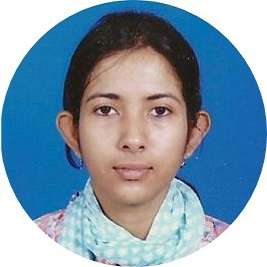 Dr Trisha Roy, Scientist (Soils), ICAR – Indian Institute of Soil and Water Conservation, Dehradun, Uttarakhand, India (email: trisha17.24@gmail.com)
Dr Trisha Roy, Scientist (Soils), ICAR – Indian Institute of Soil and Water Conservation, Dehradun, Uttarakhand, India (email: trisha17.24@gmail.com)
 Dr Gopal Kumar, Principal Scientist (Soils) ICAR – Indian Institute of Soil and Water Conservation, Dehradun, Uttarakhand, India (email: gkcswcrti@gmail.com)
Dr Gopal Kumar, Principal Scientist (Soils) ICAR – Indian Institute of Soil and Water Conservation, Dehradun, Uttarakhand, India (email: gkcswcrti@gmail.com)
 Dr M Madhu, Director, ICAR – Indian Institute of Soil and Water Conservation, Dehradun, Uttarakhand, India (email: l: directorsoilcons@gmail.com; director.iiswc@icar.gov.in)
Dr M Madhu, Director, ICAR – Indian Institute of Soil and Water Conservation, Dehradun, Uttarakhand, India (email: l: directorsoilcons@gmail.com; director.iiswc@icar.gov.in)



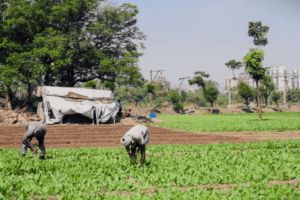

“I congratulate the authors Trisha Roy, Gopal Kumar and M Madhu in highlighting the urgency to resort to soil conservation measures to save the planet. This blog has raised many questions than it has answered. When the watershed management programmes have been successfully implemented why the focus was shifted away from the watershed management in the country? What are the current govt programmes on sustainable soil management being implemented in the country? As indicated by the authors, it is not possible to address this complex issue of soil conservation without an appropriate policy (with sufficient budget allocation) and strengthening the EAS.
They, being the scientists of soil conservation institute should have come out with an appropriate strategy to address this important issue of soil conservation”